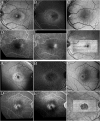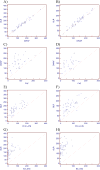ABNORMAL RETINAL REFLECTIVITY TO SHORT-WAVELENGTH LIGHT IN TYPE 2 IDIOPATHIC MACULAR TELANGIECTASIA
- PMID: 28644304
- PMCID: PMC5726908
- DOI: 10.1097/IAE.0000000000001728
ABNORMAL RETINAL REFLECTIVITY TO SHORT-WAVELENGTH LIGHT IN TYPE 2 IDIOPATHIC MACULAR TELANGIECTASIA
Abstract
Purpose: Macular telangiectasia Type 2 (MacTel) is a bilateral, progressive, potentially blinding retinal disease characterized by vascular and neurodegenerative signs, including an increased parafoveal reflectivity to blue light. Our aim was to investigate the relationship of this sign with other signs of macular telangiectasia Type 2 in multiple imaging modalities.
Methods: Participants were selected from the MacTel Type 2 study, based on a confirmed diagnosis and the availability of images. The extent of signs in blue-light reflectance, fluorescein angiographic, optical coherence tomographic, and single- and dual-wavelength autofluorescence images were analyzed.
Results: A well-defined abnormality of the perifovea is demonstrated by dual-wavelength autofluorescence and blue-light reflectance in early disease. The agreement in area size of the abnormalities in dual-wavelength autofluorescence and in blue-light reflectance images was excellent: for right eyes: ρ = 0.917 (P < 0.0001, 95% confidence interval 0.855-0.954, n = 46) and for left eyes: ρ = 0.952 (P < 0.0001, 95% confidence interval 0.916-0.973, n = 49). Other changes are less extensive initially and expand later to occupy that area and do not extend beyond it.
Conclusion: Our findings indicate that abnormal metabolic handling of luteal pigment and physical changes giving rise to increased reflectance are widespread in the macula throughout the natural history of the disease, precede other changes, and are relevant to early diagnosis.
Conflict of interest statement
Proprietary interest: no conflicting relationship exists for any author.
Figures



References
Publication types
MeSH terms
Supplementary concepts
Grants and funding
LinkOut - more resources
Full Text Sources
Other Literature Sources

